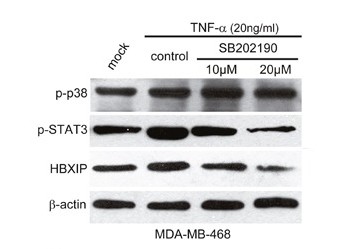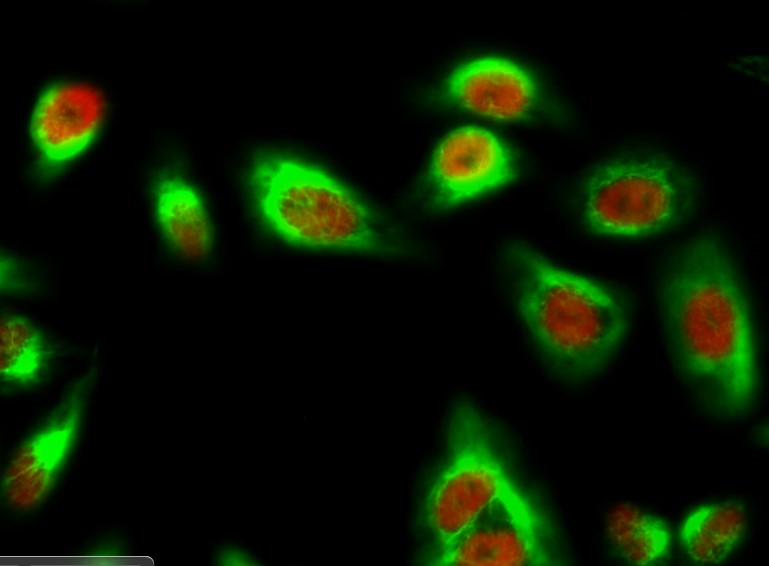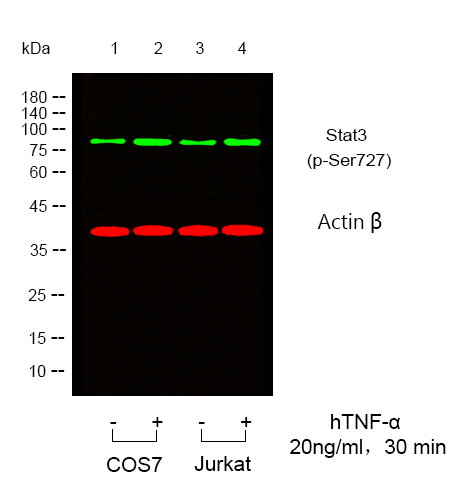Stat3 (phospho Ser727) Polyclonal Antibody
- Catalog No.:YP0250
- Applications:IF;WB;IHC;IP;ELISA
- Reactivity:Human;Mouse;Rat;Monkey
- Target:
- Stat3
- Fields:
- >>EGFR tyrosine kinase inhibitor resistance;>>Chemokine signaling pathway;>>HIF-1 signaling pathway;>>FoxO signaling pathway;>>Necroptosis;>>Signaling pathways regulating pluripotency of stem cells;>>JAK-STAT signaling pathway;>>Th17 cell differentiation;>>Prolactin signaling pathway;>>Adipocytokine signaling pathway;>>Insulin resistance;>>AGE-RAGE signaling pathway in diabetic complications;>>Growth hormone synthesis, secretion and action;>>Toxoplasmosis;>>Hepatitis C;>>Hepatitis B;>>Measles;>>Human cytomegalovirus infection;>>Kaposi sarcoma-associated herpesvirus infection;>>Epstein-Barr virus infection;>>Coronavirus disease - COVID-19;>>Pathways in cancer;>>Viral carcinogenesis;>>Proteoglycans in cancer;>>MicroRNAs in cancer;>>Chemical carcinogenesis - receptor activation;>>Pancreatic cancer;>>Acute myeloid leukemia;>>Non-small cell lung cancer;>>PD-L1 expression and PD-1 checkpoint pathway in cancer;>>Inflammatory bowel disease;>>Lipid and atherosclerosis
- Gene Name:
- STAT3
- Protein Name:
- Signal transducer and activator of transcription 3
- Human Gene Id:
- 6774
- Human Swiss Prot No:
- P40763
- Mouse Gene Id:
- 20848
- Mouse Swiss Prot No:
- P42227
- Rat Gene Id:
- 25125
- Rat Swiss Prot No:
- P52631
- Immunogen:
- The antiserum was produced against synthesized peptide derived from human STAT3 around the phosphorylation site of Ser727. AA range:694-743
- Specificity:
- Phospho-Stat3 (S727) Polyclonal Antibody detects endogenous levels of Stat3 protein only when phosphorylated at S727.
- Formulation:
- Liquid in PBS containing 50% glycerol, 0.5% BSA and 0.02% sodium azide.
- Source:
- Polyclonal, Rabbit,IgG
- Dilution:
- IF 1:50-200 WB 1:500 - 1:2000. IHC 1:100 - 1:300. Immunoprecipitation: 2-5 ug:mg lysate. ELISA: 1:10000. Not yet tested in other applications.
- Purification:
- The antibody was affinity-purified from rabbit antiserum by affinity-chromatography using epitope-specific immunogen.
- Concentration:
- 1 mg/ml
- Storage Stability:
- -15°C to -25°C/1 year(Do not lower than -25°C)
- Other Name:
- STAT3;APRF;Signal transducer and activator of transcription 3;Acute-phase response factor
- Observed Band(KD):
- 85kD
- Background:
- The protein encoded by this gene is a member of the STAT protein family. In response to cytokines and growth factors, STAT family members are phosphorylated by the receptor associated kinases, and then form homo- or heterodimers that translocate to the cell nucleus where they act as transcription activators. This protein is activated through phosphorylation in response to various cytokines and growth factors including IFNs, EGF, IL5, IL6, HGF, LIF and BMP2. This protein mediates the expression of a variety of genes in response to cell stimuli, and thus plays a key role in many cellular processes such as cell growth and apoptosis. The small GTPase Rac1 has been shown to bind and regulate the activity of this protein. PIAS3 protein is a specific inhibitor of this protein. Mutations in this gene are associated with infantile-onset multisystem autoimmune disease and hyper
- Function:
- disease:Defects in STAT3 are the cause of hyperimmunoglobulin E recurrent infection syndrome autosomal dominant (AD-HIES) [MIM:147060]; also known as hyper-IgE syndrome or Job syndrome. AD-HIES is a rare disorder of immunity and connective tissue characterized by immunodeficiency, chronic eczema, recurrent Staphylococcal infections, increased serum IgE, eosinophilia, distinctive coarse facial appearance, abnormal dentition, hyperextensibility of the joints, and bone fractures.,function:Transcription factor that binds to the interleukin-6 (IL-6)-responsive elements identified in the promoters of various acute-phase protein genes. Activated by IL31 through IL31RA.,miscellaneous:Involved in the gp130-mediated signaling pathway.,online information:STAT3 entry,online information:STAT3 mutation db,PTM:Tyrosine phosphorylated in response to IL-6, IL-11, CNTF, LIF, CSF-1, EGF, PDGF, IFN-alpha an
- Subcellular Location:
- Cytoplasm . Nucleus . Shuttles between the nucleus and the cytoplasm. Translocated into the nucleus upon tyrosine phosphorylation and dimerization, in response to signaling by activated FGFR1, FGFR2, FGFR3 or FGFR4. Constitutive nuclear presence is independent of tyrosine phosphorylation. Predominantly present in the cytoplasm without stimuli. Upon leukemia inhibitory factor (LIF) stimulation, accumulates in the nucleus. The complex composed of BART and ARL2 plays an important role in the nuclear translocation and retention of STAT3. Identified in a complex with LYN and PAG1.
- Expression:
- Heart, brain, placenta, lung, liver, skeletal muscle, kidney and pancreas. Expressed in naive CD4(+) T cells as well as T-helper Th17, Th1 and Th2 cells (PubMed:31899195).
PRKAR2A-derived circular RNAs promote the malignant transformation of colitis and distinguish patients with colitis-associated colorectal cancer Clin Transl Med. 2022 Feb;12(2):e683. WB,ISH Mouse 1: 200,1:1000 colon
Effects and Molecular Mechanism of Single-Nucleotide Polymorphisms of MEG3 on Porcine Skeletal Muscle Development. Frontiers in Genetics Front Genet. 2021 Feb;12:206 WB Porcine 1 : 1000 Porcine skeletal muscle satellite cells
Suppressed androgen receptor expression promotes M2 macrophage reprogramming through the STAT3/SOCS3 pathway. EXCLI Journal Excli J. 2019; 18: 21–29 WB Mouse 1:500 Raw264.7 cell
Dl-3-n-Butylphthalide Promotes Remyelination and Suppresses Inflammation by Regulating AMPK/SIRT1 and STAT3/NF-κB Signaling in Chronic Cerebral Hypoperfusion. Frontiers in Aging Neuroscience Front Aging Neurosci. 2020 Jun;0:137 WB Rat 1:1000 White matter
Inflammatory factor TNF-α promotes the growth of breast cancer via the positive feedback loop of TNFR1/NF-κB (and/or p38)/p-STAT3/HBXIP/TNFR1. Oncotarget Oncotarget. 2017 Aug 29; 8(35): 58338–58352 WB Human MDA-MB-468 cell
N′-[(3-[benzyloxy]benzylidene]-3,4,5-trihydroxybenzohydrazide (1) protects mice against colitis induced by dextran sulfate sodium through inhibiting NFκB/IL-6/STAT3 pathway. BIOCHEMICAL AND BIOPHYSICAL RESEARCH COMMUNICATIONS Biochem Bioph Res Co. 2016 Aug;477:290 WB Mouse 1:1000 colon
Cancer Stem Cells are Regulated by STAT3 Signalling in Wilms Tumour. Journal of Cancer J Cancer. 2018; 9(8): 1486–1499 WB Human,Mouse 1:1000 G401-Xenografts G401 cell
IL-10/STAT3 is reduced in childhood obesity with hypertriglyceridemia and is related to triglyceride level in diet-induced obese rats. BMC Endocrine Disorders Bmc Endocr Disord. 2018 Dec;18(1):1-9 IHC Rat perirenal adipose tissue,epididymal adipose tissue
Downregulation of RIPK4 Expression Inhibits Epithelial-Mesenchymal Transition in Ovarian Cancer through IL-6. Journal of Immunology Research J Immunol Res. 2021;2021:8875450 WB Human 1 : 1000 SKOV3 cell
Tang, Qiusha, et al. "Combination of PEI-Mn0. 5Zn0. 5Fe2O4 nanoparticles and pHsp 70-HSV-TK/GCV with magnet-induced heating for treatment of hepatoma." International journal of nanomedicine 10 (2015): 7129.
N′-[(3-[benzyloxy] benzylidene]-3, 4, 5-trihydroxybenzohydrazide (1) protects mice against colitis induced by dextran sulfate sodium through inhibiting NFκB/IL-6/STAT3 pathway." Biochemical and biophysical research communications 477.2 (2016): 290-296.
Targeting androgen receptor with ASC-J9 attenuates cardiac injury and dysfunction in experimental autoimmune myocarditis by reducing M1-like macrophage. BIOCHEMICAL AND BIOPHYSICAL RESEARCH COMMUNICATIONS Biochem Bioph Res Co. 2017 Apr;485:746 WB Mouse 1:500 Raw264.7 macrophages
miRNA-331-3p Affects the Proliferation, Metastasis, and Invasion of Osteosarcoma through SOCS1/JAK2/STAT3 Journal of Oncology Bing Wu WB Mouse
Cadmium contributes to atherosclerosis by affecting macrophage polarization FOOD AND CHEMICAL TOXICOLOGY Jia Song IHC,WB Mouse carotid RAW264.7 cells
Oxymatrine ameliorates rheumatoid arthritis by regulation of Tfr/Tfh cells balance via TLR9-MyD88-STAT3 signaling pathway. Yanli Zhang WB Mouse joint synovial tissue
M2 macrophage‑derived exosomes alleviate KCa3.1 channel expression in rapidly paced HL‑1 myocytes via the NF‑κB (p65)/STAT3 signaling pathway Molecular Medicine Reports Huiyu Chen WB Mouse 1:1000 HL-1 myocytes
Tetrastigma hemsleyanum polysaccharide ameliorated ulcerative colitis by remodeling intestinal mucosal barrier function via regulating the SOCS1/JAK2/STAT3 pathway INTERNATIONAL IMMUNOPHARMACOLOGY Xiaodan Bao WB,IF Mouse,Human 1:200,1:2000 colon tissue Caco-2 cell
- June 19-2018
- WESTERN IMMUNOBLOTTING PROTOCOL
- June 19-2018
- IMMUNOHISTOCHEMISTRY-PARAFFIN PROTOCOL
- June 19-2018
- IMMUNOFLUORESCENCE PROTOCOL
- September 08-2020
- FLOW-CYTOMEYRT-PROTOCOL
- May 20-2022
- Cell-Based ELISA│解您多样本WB检测之困扰
- July 13-2018
- CELL-BASED-ELISA-PROTOCOL-FOR-ACETYL-PROTEIN
- July 13-2018
- CELL-BASED-ELISA-PROTOCOL-FOR-PHOSPHO-PROTEIN
- July 13-2018
- Antibody-FAQs
- Products Images
.jpg)
- Jiao, Z., Ma, Y., Zhang, Q. et al. The adipose-derived mesenchymal stem cell secretome promotes hepatic regeneration in miniature pigs after liver ischaemia-reperfusion combined with partial resection. Stem Cell Res Ther 12, 218 (2021).

- Tang, Qiusha, et al. "Combination of PEI-Mn0. 5Zn0. 5Fe2O4 nanoparticles and pHsp 70-HSV-TK/GCV with magnet-induced heating for treatment of hepatoma." International journal of nanomedicine 10 (2015): 7129.

- Ma, Wenhan, et al. "Suppressed androgen receptor expression promotes M2 macrophage reprogramming through the STAT3/SOCS3 pathway." EXCLI JOURNAL 18 (2019): 21-29.

- Cai, Xiaoli, et al. "Inflammatory factor TNF-α promotes the growth of breast cancer via the positive feedback loop of TNFR1/NF-κB (and/or p38)/p-STAT3/HBXIP/TNFR1." Oncotarget 8.35 (2017): 58338.

- Immunofluorescence analysis of Hela cell. 1,Stat3 (phospho Ser727) Polyclonal Antibody(red) was diluted at 1:200(4° overnight). Caspase 9 Monoclonal Antibody(3-20)(green) was diluted at 1:200(4° overnight). 2, Goat Anti Rabbit Alexa Fluor 594 Catalog:RS3611 was diluted at 1:1000(room temperature, 50min). Goat Anti Mouse Alexa Fluor 488 Catalog:RS3208 was diluted at 1:1000(room temperature, 50min).
if-rat-heart127.jpg)
- Immunofluorescence analysis of rat-heart tissue. 1,Stat3 (phospho Ser727) Polyclonal Antibody(red) was diluted at 1:200(4°C,overnight). 2, Cy3 labled Secondary antibody was diluted at 1:300(room temperature, 50min).3, Picture B: DAPI(blue) 10min. Picture A:Target. Picture B: DAPI. Picture C: merge of A+B
if-rat-heart128.jpg)
- Immunofluorescence analysis of rat-heart tissue. 1,Stat3 (phospho Ser727) Polyclonal Antibody(red) was diluted at 1:200(4°C,overnight). 2, Cy3 labled Secondary antibody was diluted at 1:300(room temperature, 50min).3, Picture B: DAPI(blue) 10min. Picture A:Target. Picture B: DAPI. Picture C: merge of A+B
poly-ihc-human-uterus.jpg)
- Immunohistochemical analysis of paraffin-embedded Human-uterus tissue. 1,Stat3 (phospho Ser727) Polyclonal Antibody was diluted at 1:200(4°C,overnight). 2, Sodium citrate pH 6.0 was used for antibody retrieval(>98°C,20min). 3,Secondary antibody was diluted at 1:200(room tempeRature, 30min). Negative control was used by secondary antibody only.
poly-ihc-rat-lung.jpg)
- Immunohistochemical analysis of paraffin-embedded Rat-lung tissue. 1,Stat3 (phospho Ser727) Polyclonal Antibody was diluted at 1:200(4°C,overnight). 2, Sodium citrate pH 6.0 was used for antibody retrieval(>98°C,20min). 3,Secondary antibody was diluted at 1:200(room tempeRature, 30min). Negative control was used by secondary antibody only.
poly-ihc-mouse-kidney.jpg)
- Immunohistochemical analysis of paraffin-embedded Mouse-kidney tissue. 1,Stat3 (phospho Ser727) Polyclonal Antibody was diluted at 1:200(4°C,overnight). 2, Sodium citrate pH 6.0 was used for antibody retrieval(>98°C,20min). 3,Secondary antibody was diluted at 1:200(room tempeRature, 30min). Negative control was used by secondary antibody only.
.jpg)
- Western Blot analysis of COS7 cells using Phospho-Stat3 (S727) Polyclonal Antibody diluted at 1:2000

- Immunohistochemistry analysis of paraffin-embedded human breast carcinoma, using STAT3 (Phospho-Ser727) Antibody. The picture on the right is blocked with the phospho peptide.

- Western blot analysis of lysates from COS7,Jurkat cells, treated or untreated with TNFa, (Green)primary antibody was diluted at 1:1000, 4°over night, secondary antibody was diluted at 1:10000, 37° 1hour. (Red) loading contrl antibody was diluted at 1:5000 as loading control, 4° over night,secondary antibody was diluted at 1:10000, 37° 1hour.

